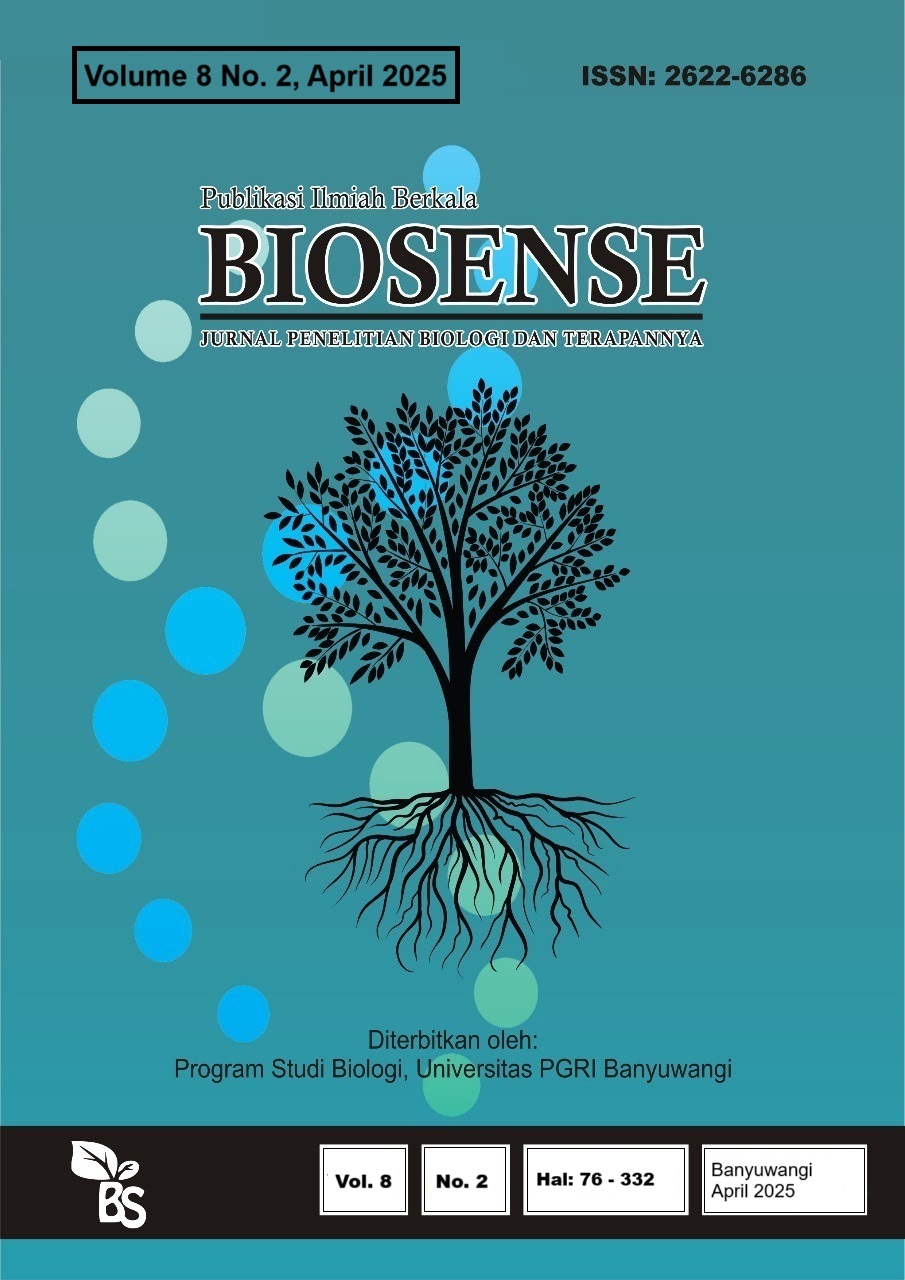KARAKTERISASI BIOKIMIA DAN RESPONS FAKTOR ABIOTIK PADA Bacillus flexus
DOI:
https://doi.org/10.36526/biosense.v8i2.5188Keywords:
Bacillus flexus, Biokimia, AbiotikAbstract
Bacillus flexus merupakan bakteri Gram-positif dengan potensi besar dalam bioteknologi dan bioremediasi karena kemampuan enzimatik dan adaptasinya terhadap lingkungan. Penelitian ini bertujuan untuk mengkarakterisasi sifat biokimia B. flexus dan responsnya terhadap faktor abiotik (suhu, pH, tekanan osmotik) guna mengoptimalkan aplikasinya. Uji biokimia menunjukkan kemampuan hidrolisis pati (produksi amilase), fermentasi glukosa, laktosa, dan manitol (heterofermentatif), serta produksi katalase. Uji abiotik mengungkap pertumbuhan optimal pada suhu mesofilik (24–26°C), pH basa (5–9), dan toleransi osmotik tinggi (sukrosa 40%, NaCl 30%). Hasil ini menegaskan potensi B. flexus sebagai penghasil enzim industri (amilase, katalase) dan agen bioremediasi di lingkungan salin/alkali. Saran untuk penelitian selanjutnya meliputi pengukuran kuantitatif aktivitas enzim dan uji aplikasi skala besar.
References
Batool, F., Shahid, M., Mahmood, F., Shahzad, T., Azeem, F., Hussain, S., Algarni, T. S., Elshikh, M. S., Wed, W. A., & Mustafa, S. (2024). Biosynthesis of copper nanoparticles using Bacillus flexus and estimation of their potential for decolorization of azo dyes and textile wastewater treatment. Journal of King Saud University - Science, 36(8). https://doi.org/10.1016/j.jksus.2024.103309
Cappuccino, J. ., & Sherman, N. (2014). Manual Laboratorium Biologi. EGC.
Dida, G. (2018). Isolation and Characterization of Starch Degrading Rhizobacteria. Open Access Journal of Microbiology & Biotechnology, 3(2), 1–8. https://doi.org/10.23880/oajmb-16000129
Jannah, S. N., Rahmadias Hanifa, Y., Utomo, A. B., Kurnia, A., Prambodo, D., Arina, D., & Lunggani, T. (2021). Isolasi dan Potensi Enzim Hidrolase Bakteri Simbion Padina sp. dari Pantai Lengkuas Belitung Isolation and Potential of Bacterial Hydrolase Enzymes Simbion Padina sp. from Lengkuas Beach Belitung. Bioma, 23(1), 11–17.
Jasmin, M. Y., Isa, N. M., Kamarudin, M. S., Lim, K. C., & Karim, M. (2024). Evaluating Bacillus flexus as bioremediators for ammonia removal in shrimp culture water and wastewater and characterizing microbial communities in shrimp pond sludge. Brazilian Journal of Microbiology, 55(1), 529–536. https://doi.org/10.1007/s42770-024-01246-9
Jebeli, M. A., Maleki, A., Amoozegar, M. A., Kalantar, E., Izanloo, H., & Gharibi, F. (2017). Bacillus flexus strain As-12, a new arsenic transformer bacterium isolated from contaminated water resources. Chemosphere, 169, 636–641. https://doi.org/10.1016/j.chemosphere.2016.11.129
Kali, A., Srirangaraj, S., & Charles, P. M. V. (2015). A cost-effective carbohydrate fermentation test for yeast using microtitre plate. Indian Journal of Medical Microbiology, 33(2), 293–295. https://doi.org/10.4103/0255-0857.154884
Khatoon, H., Chavan, D. D., Anokhe, A., & Kalia, V. (2022). AgriCos e-Newsletter. January.
Magdalena, S., Giovani, F., & Yogiara, Y. (2021). Evaluation of the potentials of Bacillus subtilis KM16 and Pseudomonas sp. PAP 26 isolated from the hot spring and crater lakes as antibiofilm agents. International Journal of Applied Biology, 5(1), 83–94. https://54.254.27.92/index.php/ijoab/article/view/13429
Maktabdar, M., Hansen, L. T., Wemmenhove, E., Gkogka, E., & Dalgaard, P. (2024). Prevalence, Characteristics, and Selection of Bacillus cereus Subgroups from Dairy Products for Challenge Testing and Predictive Model Development. Journal of Food Protection, 87(11), 100367. https://doi.org/10.1016/j.jfp.2024.100367
Miłek, J., & Lamkiewicz, J. (2022). The starch hydrolysis by α-amylase Bacillus spp.: an estimation of the optimum temperatures, the activation and deactivation energies. Journal of Thermal Analysis and Calorimetry, 147(24), 14459–14466. https://doi.org/10.1007/s10973-022-11738-1
Moraes, G. F. Q., Cordeiro, L. V., & de Andrade Júnior, F. P. (2021). Main laboratory methods used for the isolation and identification of Staphylococcus spp. Revista Colombiana de Ciencias Quimico-Farmaceuticas(Colombia), 50(1), 5–28. https://doi.org/10.15446/rcciquifa.v50n1.95444
Mulla, S. I., Ameen, F., Tallur, P. N., Bharagava, R. N., Bangeppagari, M., Eqani, S. A. M. A. S., Bagewadi, Z. K., Mahadevan, G. D., Yu, C. P., & Ninnekar, H. Z. (2017). Aerobic degradation of fenvalerate by a Gram-positive bacterium, Bacillus flexus strain XJU-4. 3 Biotech, 7(5), 1–8. https://doi.org/10.1007/s13205-017-0957-5
Saeed, S. W. Z., Naseer, I., Zahir, Z. A., Hilger, T., Shahid, S., Iqbal, Z., & Ahmad, M. (2023). Bacillus Strains with Catalase Enzyme Improve the Physiology and Growth of Rice (Oryza sativa L.). Stresses, 3(4), 736–748. https://doi.org/10.3390/stresses3040050
Saryono, Ismawati, Pratiwi, N. W., Devi, S., Sipayung, M. Y., & Suraya, N. (2023). Isolation and identification of lactic acid bacteria from traditional food sarobuong of Kuantan Singingi District, Riau, Indonesia. Biodiversitas, 24(4), 2201–2206. https://doi.org/10.13057/biodiv/d240432
Sianipar, G. W. S., Sartini, S., & Riyanto, R. (2020). Isolasi dan Karakteristik Bakteri Endofit pada Akar Pepaya (Carica papaya L). Jurnal Ilmiah Biologi UMA (JIBIOMA), 2(2), 83–92. https://doi.org/10.31289/jibioma.v2i2.312
Sura, N. K., & Hiremath, L. (2019). Isolation of Bacillus megaterium and its Commercial Importance. International Journal of ChemTech Research, 12(04), 30–36. https://doi.org/10.20902/ijctr.2019.120405
Waluyo, L. (2018). Bioremediasi Limbah: Limbah (Vol. 1). UMM Press.
Wanger, A., Chavez, V., Huang, R. S. P., Wahed, A., Actor, J. K., & Dasgupta, A. (2017). Chapter 5 - Biochemical Tests and Staining Techniques for Microbial Identification (A. Wanger, V. Chavez, R. S. P. Huang, A. Wahed, J. K. Actor, & A. B. T.-M. and M. D. in P. Dasgupta (eds.); pp. 61–73). Elsevier. https://doi.org/https://doi.org/10.1016/B978-0-12-805351-5.00005-3
Werdi, C. M., & Al-Hadidy, Y. I. (2023). Effectiveness of Bacillus clausii and Bacillus megaterium on some Physiological and Biochemical Parameters in Rats That Induced Diarrhea. IOP Conference Series: Earth and Environmental Science, 1158(11). https://doi.org/10.1088/1755-1315/1158/11/112012

















